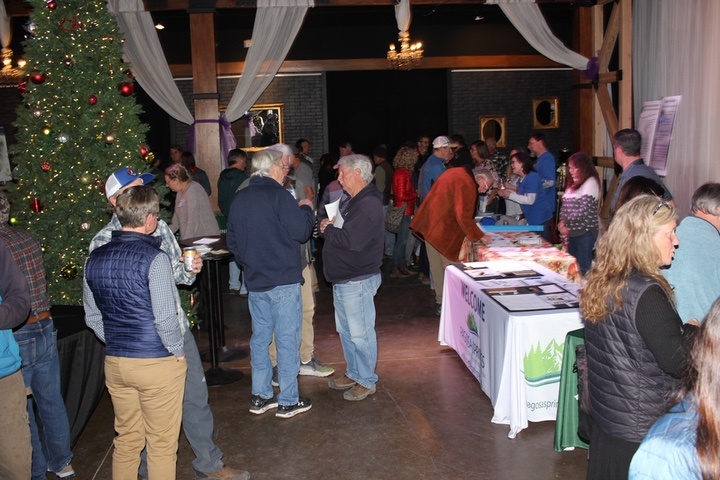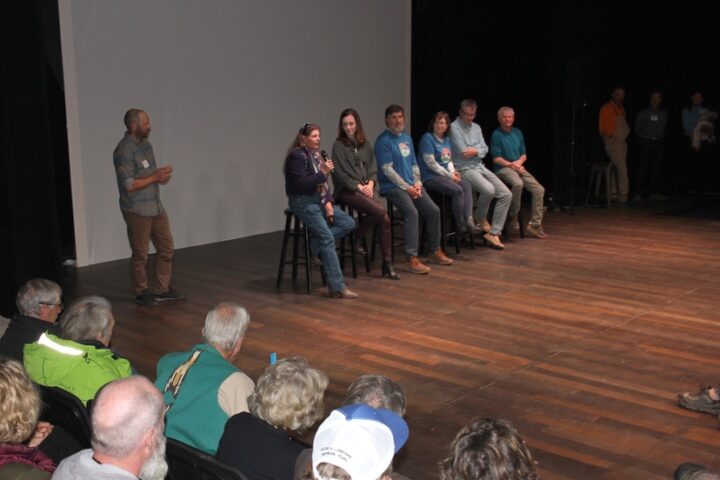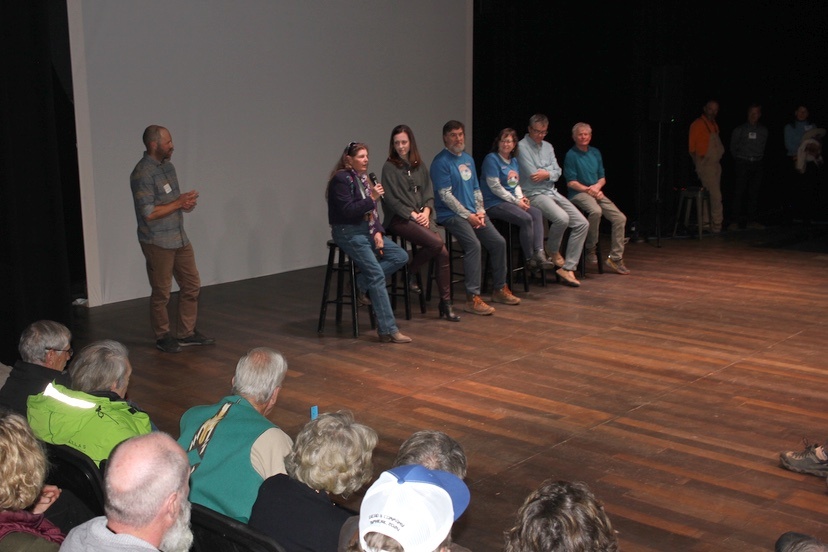Photo: A panel of local residents, connected to various water uses, fielded audience questions at the “This is Your Watershed” film event at the Pagosa Springs Center for the Arts, November 18, 2024.
A lack of trust has been evident in the ongoing debate about the proposed Dry Gulch Reservoir, which has been in the “planning” stages since 1989 and — according to at least one government agreement — was supposed to be under construction by 2025. Currently, the organization leading that “planning” effort is the San Juan Water Conservancy District. SJWCD.
At a special Pagosa Area Water and Sanitation District board meeting on November 14, the PAWSD board considered the following agenda items:
- Discussion Regarding and Consideration of SJWCD Contract Rejections, SJWCD Tenure as Project Leader of Dry Gulch Reservoir Project, and Vote of No Confidence Regarding SJWCD as Project Leader
- Discussion Regarding and Consideration of Contract Negotiations Towards a Revised Dry Gulch Reservoir Project and SJWCD Participation
- Discussion Regarding and Consideration of a PAWSD Board Declaration to Actively Sell Running Iron Ranch
- Discussion Regarding and Consideration of Disclosure, by PAWSD and SJWCD, to Potential Funding Agencies of the PAWSD Board’s Intent to Sell Running Iron Ranch
We can discern from these agenda items that the PAWSD Board had apparently lost all faith in SJWCD’s ability to create a reservoir at Dry Gulch, and in SJWCD’s willingness to help get PAWSD customers out from under $10 million in future debt payments.
However… the PAWSD board tabled all of these actions until December, to give SJWCD a chance to seriously consider an offer from the first potential partner to come forward since 2012, offering to help them build their proposed reservoir project.
Some local residents believe Pagosa Springs is headed for a dire water shortage, in the not-too-distant future. The SJWCD board seems to be among them. The PAWSD board is not among them.
In an effort to promote the idea that Pagosa Springs faces future water shortages, SJWCD obtained a grant from the Colorado Water Conservation Board to help fund a series of three short videos, to be produced by local videographer Christi Bode of Moxiecran Media.
The first two videos were shown publicly on Monday night at the Pagosa Springs Center for the Arts, at a well attended event — “This is Your Watershed” — focused on climate change and how it might affect snow pack and precipitation in the the American West. Prior to the film showing, about 200 attendees had a chance to visit with a dozen environmentally-oriented local organizations manning tables in the PSCA lobby.

There are a few types of water shortages Pagosa Springs could be concerned about. We could have a shortage of drinking water, for example.
Or our farms and ranches could run short of irrigation water. (Not likely, due to Colorado’s “first-in-time, first-in-right” seniority doctrine.)
We could also have low flows in the San Juan River, such that rubber inner tubes could no longer navigate the river. (As happened in 2002.)
Disclosure: I currently serve as a volunteer board member on the PAWSD board of directors, but this editorial reflects only my own personal opinions, and not necessarily the opinions of the PAWSD board or staff.
Following the film presentations, moderator Alex Handloff invited several local residents — film maker Christi Bode plus rafting guide Lindsay Kurt-Mason; two meteorologists, Shawn & Arleen Prochazka; rancher Becky Guilliams; and hydrology engineer Chris Pitcher — onto the stage to field questions from the standing-room-only crowd. A couple of things quickly became clear during the panel discussion.
1. The panel members had very little actual data to back up their responses.
2. The audience was full of environmentalists… as you might expect, given the subject matter of the films.

It appeared that the panel member with the most intimate knowledge of our local water resources was life-long resident and rancher Becky Guilliams, who made the somewhat surprising claim that, in her experience, the climate in southwest Colorado has become colder, rather than warmer, over the past several decades.
Another claim that surprised me (but perhaps not anyone else) was made by hydrologist Chris Pitcher, when he stated that local water issues would be best addressed by encouraging more agricultural uses in Pagosa.
My own research into water issues in the American West suggests the exact opposite: that raising cows is in fact part of the problem.
Following the panel discussion, a friend approached me (as a PAWSD board member) and suggested that PAWSD could make its customers more aware of water issues, and could encourage more water conservation, by charging “by the gallon” for drinking water. I told her I would mention her idea to the board.
Then, I suggested to her that the biggest users of water in Archuleta County are not PAWSD customers, but ranch owners raising beef cattle.
PAWSD customers use about 1,250 acre-feet of water per year, diverted from local mountain streams. That’s about 400 million gallons per year.
According to U.S. Geological Survey, irrigated crops in Archuleta County — that is, grass and alfalfa for cows — divert about 41.7 million gallons per day… or about 15,200 million gallons a year.

Over 15 billion gallons annually, for irrigation.
Put into simpler terms, more than 95% of the water diverted in Archuleta County apparently serves cows. If our ranchers could reduce their irrigation diversions by just 5%, it would save more water than if each and every PAWSD resident and business completely stopped using water.
This data could have been shared at the “This is Your Watershed” event. But it was not. Instead, we heard a recommendation that we teach children to turn off the faucet while they brush their teeth.
A few minutes later, I mentioned this agricultural water consumption data to a local fourth-generation rancher — (not Ms. Guilliams) — and I suggested that the American West could begin to address its water issues by switching from beef to chicken as our preferred protein source.
The rancher remarked, “But I’m allergic to chicken.”
We all tend to see the world from a personal point of view. That can be a problem, when we’re talking about trust.

